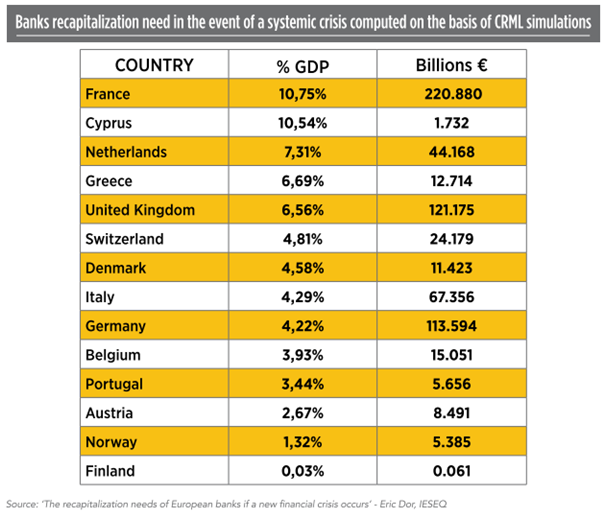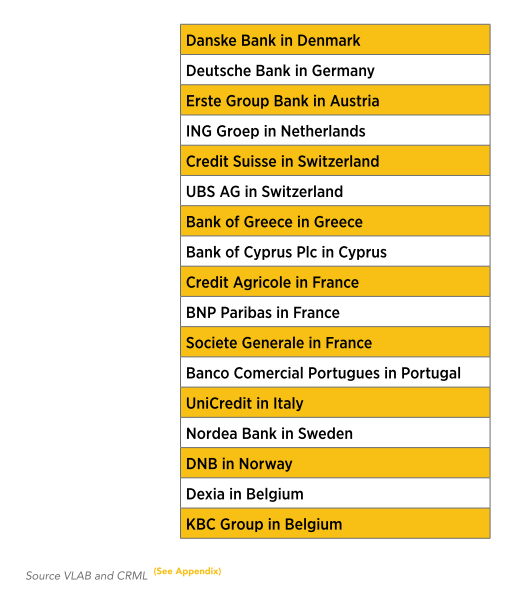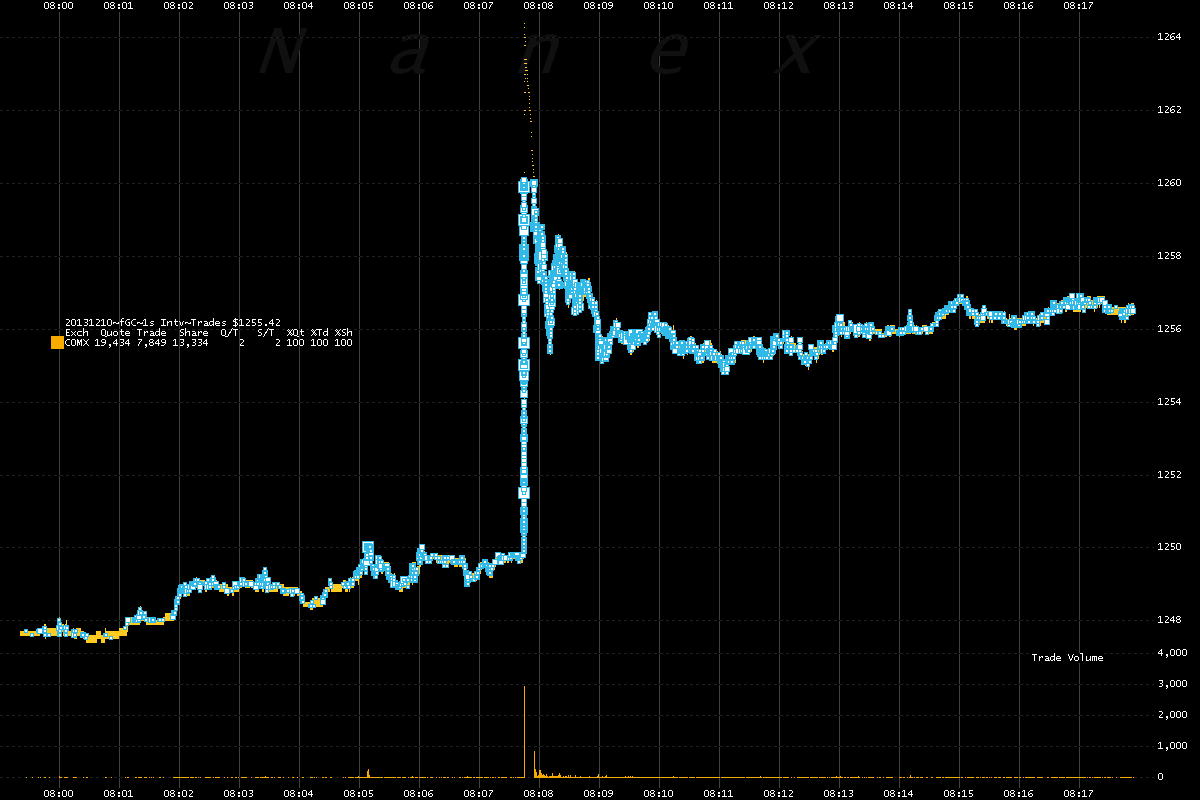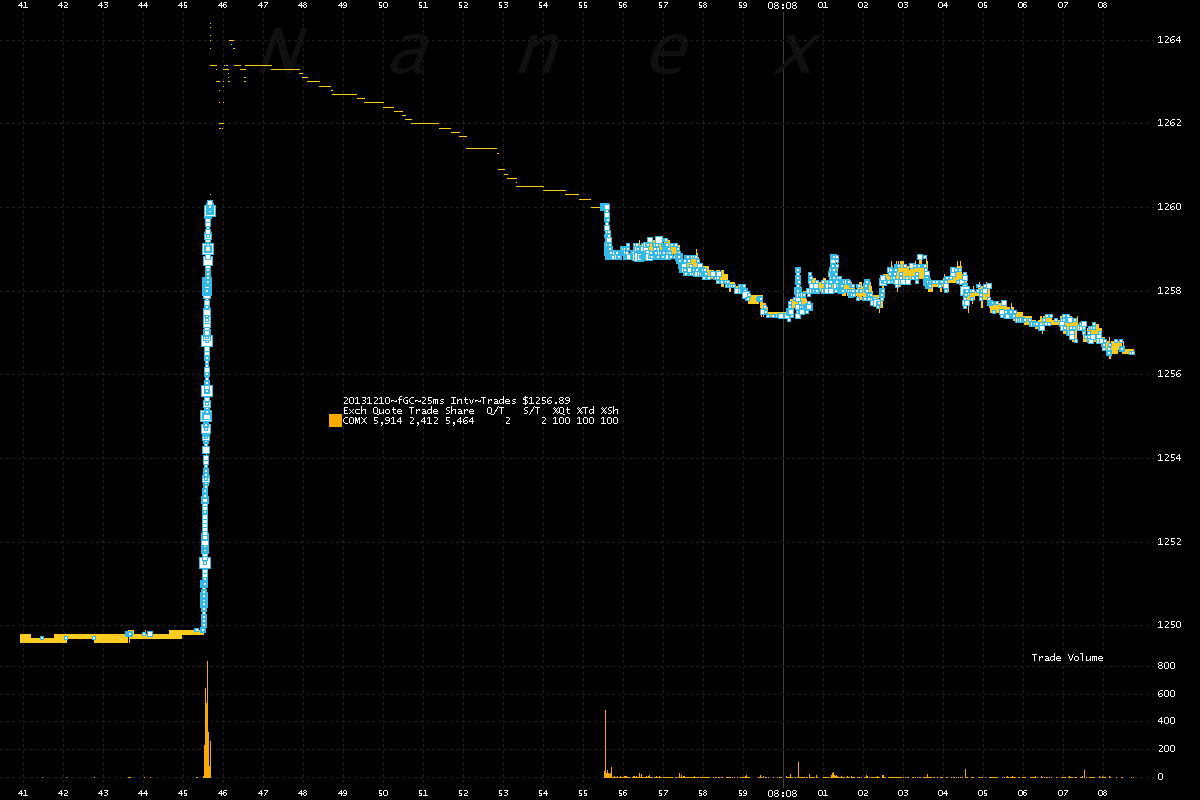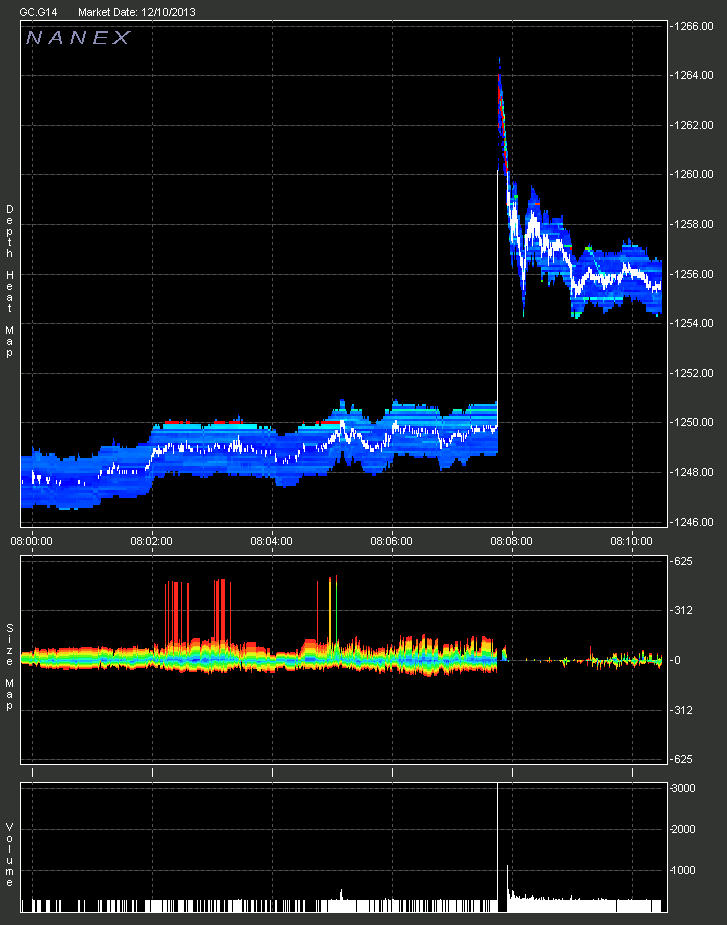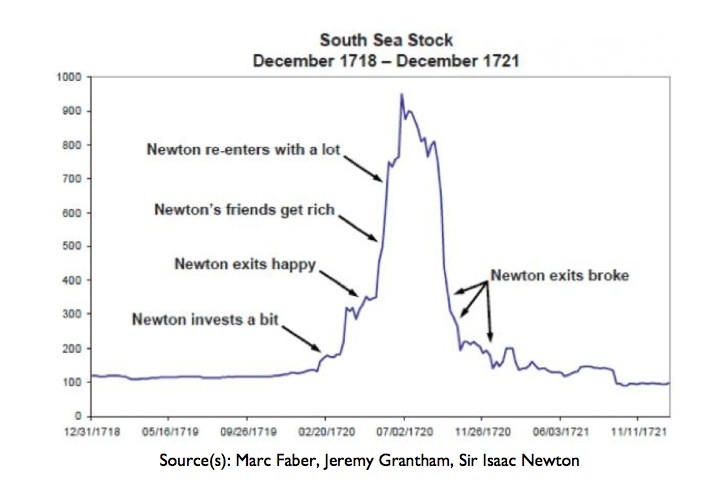- U.S. set to adopt Volcker rule to curb bank trading gambles (Reuters) After vote, lawsuits likely next hurdle for Volcker rule (Reuters)
- U.S. Congress budget talks could produce Tuesday deal, aides say (Reuters)
- Wealthy Go Frugal This Holiday Amid Uneven U.S. Recovery (BBG)
- Tearful Thai PM urges protesters to take part in election (Reuters)
- Fed’s Bullard Sees Higher QE Taper Odds as Labor Market Improves (BBG)
- Coeure Says ECB Would Offer More LTROs Only When Banks Can Lend (BBG)
- Inside China’s Super-Sterile Chicken Farms (WSJ)
- Mandela Service Rivals JFK’s as Leaders Meet in South Africa (BBG)
- China data defy slowdown forecasts (FT), and of course the word is “data”
- Cold, ice grip U.S. as more snow to blanket East (Reuters)
- Germany and France close on banking union deal (FT)
- Hidden Obamacare Website Costs Show Lack of Transparency (BBG)
- Lululemon Founder Steps Down as Chairman (WSJ)
- Singapore to Charge Rioters After Little India Violence (BBG)
- Google bus blocked in San Francisco gentrification protest (Reuters)
Overnight Media Digest
WSJ
* Regulators are set to usher in a new era of tough banking oversight on Tuesday that drills to the core of Wall Street’s profitable markets and trading businesses, according to a draft of the rule reviewed by the Wall Street Journal.
* Boeing Co is running the priciest corporate beauty contest in the United States, as state governments across the country try to outdo a record incentive package from Washington state to lure work that would build one of the aerospace company’s coming jetliners.
* Abercrombie & Fitch Co entered into a new contract with Chief Executive Michael Jeffries, thumbing its nose at an activist hedge fund that had pressed the company to look for a new leader.
* This holiday season, Santa will have extra helpers at the mall: devices that track shoppers. In dozens of U.S. shopping centers, small gadgets – perhaps tucked near the queue for a photo with Santa – will keep tabs on shoppers’ cellphones. Elsewhere, trackers sprinkled around the centers identify shoppers’ movements, helping mall operators and retailers tally how long people wait in line and where they shop.
* An annual push by doctors to delay cuts to Medicare patient fees is afoot, but this time the prognosis is better for a permanent solution to the long-festering problem. The Senate Finance Committee is scheduled to vote Thursday on “doc fix” legislation that would permanently change how Medicare providers are paid by the government for their services. Similar legislation was unanimously passed by the House Energy and Commerce Committee in July.
* The stage could be set for stronger economic growth next year, as a surging stock market and run-up in home values have helped Americans recoup nearly all the wealth they lost in the recession.
* European finance ministers were closing in on a new system for winding down sick banks, in which the failure of a lender could be partly financed by banks from other countries, two European officials said Monday.
* Hilton Worldwide Holdings Inc has accelerated the timetable for its potential $2.7 billion IPO and is now planning on pricing its shares after markets close on Wednesday, instead of on Thursday, people familiar with the matter said.
* The U.S. Department of Justice has been investigating possible sales of Dell computers to the Syrian government, the company said in documents released Monday.
* Medical-equipment maker Hologic Inc unveiled a management shake-up on Monday that includes the appointment of industry veteran Stephen MacMillan as its chief executive and the addition of two board members in a deal designed to placate activist investor Carl Icahn.
* Faced with the lowest corn prices in more than three years, many U.S. farmers are stashing away their grain in a bet on a rebound. The strategy is sending ripples through the corn belt-affecting everyone from grain buyers to storage-bin makers-and tempering the price declines in the $27 billion corn-futures market.
FT
Foreign banks in China have warned that they will lose a critical source of funding and revenue if Beijing enforces its new regulations to restrict interbank lending by domestic banks.
Medical device maker Hologic Inc appointed two directors backed by activist investor Carl Icahn to its board as part of a settlement with the billionaire.
Airbus parent EADS plans to cut 5,800 jobs at its defence businesses and close sites in Paris, Munich, Spain and Britain as it tries to lift its weak profit margins and cope with the steep cuts in European defence budgets.
The U.S. government said it had sold the last of its stake in General Motors, marking an end to a historic bailout of the country’s biggest automaker.
Sysco Corp said it would buy rival US Foods Inc for$8.2 billion including debt, in a deal that will combine the top two U.S. food distributors.
NYT
* The government bailout of General Motors ended on Monday with the Treasury Department’s announcement that it had sold its final shares of GM stock. The sale closes a tumultuous chapter in the history of the American auto industry, and allows the nation’s largest automaker to continue its comeback free from the stigma of being known as “Government Motors.”
* The Finnish cellphone giant Nokia is expected on Tuesday to offer almost $400 million to resolve a tax dispute with Indian authorities ahead of the company’s planned sale of its handset business to Microsoft for $7.2 billion.
* Output at German factories, mines and power plants declined in October for a second straight month, official data showed on Monday, the latest sign that the economy at the heart of the euro zone recovery might not be growing as quickly as had been hoped.
* Not limiting their activities to the earthly realm, American and British spies have infiltrated the fantasy worlds of World of Warcraft and Second Life, conducting sur
veillance and scooping up data in the online games played by millions of people across the globe, according to newly disclosed classified documents.
* The advent of a new medium to conduct business inevitably means avenues for criminals to swoop in to take advantage. The development of Bitcoin, the virtual currency that is not issued by any government, presents challenges for the authorities to use laws that were not designed for the digital world to combat illegal conduct.
* Shortly after 1 a.m. on a day nearly a year ago, Cerberus Capital Management announced that it planned to sell its gun manufacturing company, the Freedom Group, after the deadly school shooting in Connecticut four days earlier. But the efforts to sell the company, which produced the Bushmaster rifle that Adam Lanza used in his assault on Sandy Hook Elementary School in Newtown, Conn., have been hamstrung by the public furor that prompted the auction in the first place.
* European Aeronautic Defense and Space, the parent company of Airbus, announced plans on Monday to cut 5,800 jobs from its military and space divisions over the next three years as it responds to reductions in European military budgets driven by austerity measures.
* The billionaire trader Steven A. Cohen is one step closer to converting his onetime $15 billion hedge fund into a family office after a tentative deal to sell a reinsurance firm he formed in 2012. Hamilton Reinsurance Group – a privately held firm led by the former insurance executive Brian Duperreault and Two Sigma Investments – will be buying the firm, known as SAC Re Ltd, for an undisclosed amount.
* When you think about Nelson Mandela, you probably think about freedom – free people, free country, free speech. What may be overshadowed by Mandela’s extraordinary legacy was his complicated journey to support free markets and a free economy.
Canada
THE GLOBE AND MAIL
* First Nations are threatening to challenge Quebec’s new Mining Act in court after the government cut short debate to force passage of the bill. Innu Chief Gilbert Dominique, a spokesperson for the Assembly of First Nations of Quebec and Labrador, warned on Monday that any new mining project on aboriginal land would be blocked if it failed to meet the approval of native communities.
* Canada’s Foreign Affairs Minister John Baird said his government intended to lay claim to the North Pole, but is delaying a full international bid for seabed rights in the resource-rich Arctic until scientists gather sufficient data to back up this territorial expansion.
Reports in the business section:
* Chip Wilson is stepping down as chairman of yoga apparel retailer Lululemon Athletica Inc, a decision made about a month after he touched off a controversy by suggesting that women’s body shapes were to blame for the chain’s problems with its black pants.
* Canada’s top 1 percent of earners took home 10.6 percent of the country’s income in 2011, a share that plateaued from a year earlier but remains higher than in recent decades.
* Canadian Oil Sands Ltd has tapped insiders to fill the company’s top two executive positions, with Ryan Kubik taking over as its chief executive in the new year.
NATIONAL POST
* Ontario’s governing Liberals plan to bring in legislation in the new year to cap the salaries of senior executives in the broader public sector – a key New Democratic Party demand. The minority Liberals agreed to the New Democrats’ request last spring in order to pass their budget and avoid an election.
* As Britain enacts laws forcing Internet companies to block access to pornography unless customers opt in, a fledgling movement is under way to bring similar laws to Canada.
FINANCIAL POST
* Major energy companies in Western Canada are bracing for another cycle of rising costs, as planned oil sands expansion and natural gas export terminals revive fears of skill shortages and competition for materials.
* Revenu-Quebec is seeking prison sentences and fines totaling $750 million for Kitco Metals Inc founder Bart Kitner and directors with several other gold trading firms following one of the biggest tax fraud investigations in provincial history.
* Canadian Business magazine is merging with PROFIT and the combined publication will put out a reduced number of issues, Rogers Communications Inc said on Monday. The Toronto-based telecom giant’s publishing division owns both of the titles and said in a statement that the new magazine, which would operate under the Canadian Business brand, would publish monthly, starting Jan. 16.
China
SHANGHAI SECURITIES NEWS
– Chinese cities and provinces including Shanghai, Shenzhen, Chongqing and Wuxi plan to roll out policies that will accelerate reform of state-owned enterprises.
– An unidentified investor bought 1.13 billion Shanghai-traded shares of China Merchants Bank on Monday through block trades at 12.07 yuan ($1.99), representing a 10.7 percent premium to the market price and valuing the deal at 13.67 billion yuan.
– Shanghai Port Group said it plans to buy 4.6 billion yuan worth of shares to be newly issued by Bank of Shanghai Co Ltd.
– Oriental Securities has become China’s first brokerage to launch a mutual fund, after regulators expanded the business scope of Chinese securities firms.
CHINA DAILY
– The first report to rank court transparency in China was published on Monday, as part of efforts to encourage judicial openness. The report by the Chinese Academy of Social Sciences’ Institute of Law looked at 103 courts in Zhejiang province.
PEOPLE’S DAILY
– The paper that acts as the government’s mouthpiece is starting a new column on Tuesday to highlight China’s changes over the last year. The column will cover new achievements and ideas among others.
Britain
The Telegraph
BANKERS FACE ‘ANNUAL HEALTH CHECK’ UNDER REFORMS
Banks will be required to give regulators an annual health check on all their senior staff to confirm they are suitable to keep their “authorised” status in the UK.
DRAX’S 2 BLN STG ‘CLEAN COAL’ PROJECT WINS GOVERNMENT FUNDING
Plans to capture carbon dioxide emissions from power stations and bury them under the North Sea moved a step closer on Monday as the British Government awarded funding to Drax to develop a proposed “clean coal” plant in Yorkshire.
H&M COULD RAISE PRICES TO PAY FOR HIGHER WAGES
Swedish fashion giant H&M, which has 226 stores in the UK, has warned it could raise retail prices in order to pay better wages to some of the world’s poorest textile workers.
The Guardian
UK ECONOMY NEEDS SUSTAINED LOW INTEREST RATES, SAYS MARK CARNEY
Britain’s economy needs sustained low interest rates to spur growth and repair the stricken banking sector, the Bank of England Governor Mark Carney has warned, in a strong rebuttal of critics calling for a rapid rate hike in response to a galloping housing market.
ROYAL MAIL WORKERS WIN PAY INCREASE OF 9 PCT OVER THREE YEARS
Royal Mail staff will get a pay increase of more than 9 percent over three years after the company and its union announced what they said was a groundbreaking legal agreement on industrial relations at the newly privatised company.
The Times
RYANAIR BOWS TO PASSENGERS ON BAGGAGE
Passengers habitually stung by Ryanair’s hefty fees for overweight bags were given relief yesterday as the Irish airline halved its charges as part of an attempt to overhaul its dismal reputation for customer service.
BRITONS FLICK SWITCH ON THE BIG SIX
The number of homes switching energy supplier to secure a better deal hit a three-year high last month in the wake of the inflation-busting rises in gas and electricity bill
s.
The Independent
HSBC RETAIL ARM SPIN-OFF TALK FAILS TO IMPRESS THE CITY
City insiders today played down talk that HSBC could be planning to float off a slug of its UK High Street business with a potential value of 20 billion pounds
Fly On The Wall 7:00 AM Market Snapshot
ANALYST RESEARCH
Upgrades
Blackhawk (HAWK) upgraded to Buy from Neutral at Citigroup
CGG SA (CGG) upgraded to Outperform from Market Perform at Raymond James
Celgene (CELG) upgraded to Outperform from Neutral at Credit Suisse
Geron (GERN) upgraded to Buy from Hold at Needham
Harman (HAR) upgraded to Outperform from Market Perform at Wells Fargo
Hellenic Telecom (HLTOY) upgraded to Overweight from Neutral at JPMorgan
Johnson Controls (JCI) upgraded to Top Pick from Outperform at RBC Capital
Royal Dutch Shell (RDS.A) upgraded to Neutral from Underweight at JPMorgan
United Rentals (URI) upgraded to Top Pick from Outperform at RBC Capital
Downgrades
Edwards Lifesciences (EW) downgraded to Market Perform at Wells Fargo
Home Properties (HME) downgraded to Underweight from Equal Weight at Morgan Stanley
Quest Diagnostics (DGX) downgraded to Underperform from Buy at BofA/Merrill
Tenneco (TEN) downgraded to Outperform from Top Pick at RBC Capital
Initiations
3D Systems (DDD) initiated with a Buy at Deutsche Bank
AFC Enterprises (AFCE) initiated with a Buy at Jefferies
Allegion (ALLE) initiated with an Outperform at Credit Suisse
Allete (ALE) initiated with a Buy at Wunderlich
Athlon Energy (ATHL) initiated with a Buy at Topeka
AvalonBay (AVB) initiated with an Equal Weight at Morgan Stanley
Bonanza Creek (BCEI) initiated with a Neutral at Mizuho
ExOne (XONE) initiated with a Hold at Deutsche Bank
PDC Energy (PDCE) initiated with a Buy at Mizuho
Papa John’s (PZZA) initiated with a Hold at Jefferies
Quanta Services (PWR) coverage resumed with a Neutral at Goldman
Rambus (RMBS) initiated with a Buy at Jefferies
Relypsa (RLYP) initiated with an Overweight at Morgan Stanley
RigNet (RNET) initiated with an Outperform at William Blair
Spectra Energy (SE) initiated with a Sector Performer at CIBC
Stratasys (SSYS) initiated with a Buy at Deutsche Bank
Synergy Resources (SYRG) initiated with a Buy at Mizuho
zulily (ZU) initiated with a Buy at BofA/Merrill
zulily (ZU) initiated with a Neutral at Citigroup
zulily (ZU) initiated with a Neutral at Goldman
zulily (ZU) initiated with a Sector Perform at RBC Capital
HOT STOCKS
Treasury sold remaining stake in General Motors (GM)
Volvo (VOLVY) to sell Volvo Rents in North America for about $1.1B
Lloyds Banking (LYG) to sell 21% stake in St. James Place
lululemon (LULU) founder, non-executive chairman Chip Wilson to resign
Rambus (RMBS), Micron (MU) signed broad patent cross license agreement
Avan Projects acquired controlling interest in Papa John’s India (PZZA)
Vitran (VTNC) to be acquired by Manitoulin Transport for $6.00 per share
Vail Resorts (MTN) reaffirmed FY14 EBITDA $280M-$295M
EARNINGS
Companies that beat consensus earnings expectations last night and today include: Burlington Stores (BURL), HD Supply (HDS), Toll Brothers (TOL), ABM Industries (ABM), Medley Capital (MCC), Alico (ALCO), Comtech (CMTL), PVH Corp. (PVH)
Companies that missed consensus earnings expectations include:
Leidos (LDOS), Triangle Petroleum (TPLM), Pep Boys (PBY), Vail Resorts (MTN), Casey’s General Stores (CASY)
Companies that matched consensus earnings expectations include:
Synergetics (SURG)
NEWSPAPERS/WEBSITES
- Regulators are set to usher in a new era of tough banking oversight today that drills to the core of Wall Street’s profitable markets and trading businesses, according to a draft of the Volcker rule reviewed by the Wall Street Journal
- Boeing (BA) is running the priciest corporate beauty contest in the U.S., as state governments across the country try to outdo a record incentive package from Washington state to lure work that would build one of the aerospace company’s coming jetliners, the Wall Street Journal reports
- St. Louis Fed President James Bullard, sometimes seen as a bellwether for U.S. monetary policy, unexpectedly offered his voice to a growing contingent at the central bank that has argued for reducing the Fed’s bond buying at a meeting next week, Reuters reports
- Time Warner Cable’s (TWC) incoming CEO Rob Marcus said he’s in no hurry to sell the company, while Charter’s (CHTR) CEO Tom Rutledge, a potential suitor, said the smaller company sees benefits in growing through acquisitions, Reuters reports
- Nokia (NOK) is ready to pay at least $487M to India’s tax authorities to enable the transfer of a factory in the country to Microsoft (MSFT), sources say, Bloomberg reports
SYNDICATE
Ares Capital (ARCC) files to sell 14.3M shares of common stock
Darling (DAR) files to sell 40M shares of common stock
EVERTEC (EVTC) files to sell 15.29M shares of common stock for holders
Icahn Enterprises (IEP) announces sale of 2M depositary units for limited partners
NXP Semiconductors (NXPI) files to sell 25M shares of common stock for holders
Pinnacle Foods (PF) files to sell 17M shares of common stock for holders
Post Holdings (POST) to offer $300M of convertible preferred stock
StealthGas (GASS) files to sell 10M shares of common stock
Taminco (TAM) files to sell 10M shares for holders
TravelCenters (TA) files to sell 5M shares of common stock







via Zero Hedge http://feedproxy.google.com/~r/zerohedge/feed/~3/HlFfg95v66w/story01.htm Tyler Durden
![]()





 The National Security
The National Security According to the Los Angeles Times, 18 current
According to the Los Angeles Times, 18 current


